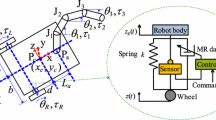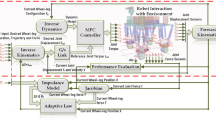Abstract
This paper presents a single degree of freedom suspension system to assist small six degree of freedom robots manipulating heavy payload. The goal of the system is to reduce the load applied to the last link of a robot manipulating a payload that is heavier than the robot’s specified allowable load capacity. An assistive suspension system was implemented to realize vertical-only motion of the robot. A mathematical model was derived, and a proportional-integral-derivative controller with an inner velocity loop was designed. Variable parameters in the model such as friction coefficients were identified in an experiment on the voltage input and velocity output. To determine how much the assistive system reduces the load on the robot, the system was connected to the robot using an interface attached with magnets and a force sensor was fixed to the last link of the robot. In the experiment, the cable tension was measured and controlled to satisfy the design preference for the assistive system to be stand-alone, rather than relying on force sensor on the robot. The experiment was performed using various control gains under different conditions, such as the periods of input motion and payload weight. The results showed that the system could reduce 3.8 and 6.0 kg payloads on the robot to 50% and 40%, respectively.
Similar content being viewed by others
References
Abolmaesumi, P., Salcudean, S. E., Zhu, W. H., Sirouspour, M. R., and DiMaio, S. P., “Image-Guided Control of a Robot for Medical Ultrasound,” IEEE Transactions on Robotics and Automation, Vol. 18, No. 1, pp. 11–23, 2002.
Salcudean, S., Bell, G., Bachmann, S., Zhu, W. H., Abolmaesumi, P., and Lawrence, P. D., “Robot-assisted Diagnostic Ultrasound-Design and Feasibility Experiments,” Medical Image Computing and Computer-Assisted Intervention, Vol. 1679, pp. 1062–1071, 1999.
Vilchis, A., Troccaz, J., Cinquin, P., Masuda, K., and Pellissier, F., “A New Robot Architecture for Tele-Echography,” IEEE Transactions on Robotics and Automation, Vol. 19, No. 5, pp. 922–926, 2003.
Burdea, G. C., Dunn, S. M., and Levy, G., “Evaluation of Robot-based Registration for Subtraction Radiography,” Medical Image Analysis, Vol. 3, No. 3, pp. 265–274, 1999.
Li, H., Yan, G., and Ma, G., “An Active Endoscopic Robot based on Wireless Power Transmission and Electromagnetic Localization,” The International Journal of Medical Robotics and Computer Assisted Surgery, Vol. 4, No. 4, pp. 355–367, 2008.
Slatkin, A. B., Burdick, J., and Grundfest, W., “The Development of a Robotic Endoscope,” Proc. of IEEE/RSJ International Conference on Intelligent Robots and Systems, Vol. 2, pp. 161–169, 1997.
Quirini, M., Menciassi, A., Scapellato, S., Stefanini, C., and Dario, P., “Design and Fabrication of a Motor Legged Capsule for the Active Exploration of the Gastrointestinal Tract,” IEEE/ASME Transactions on Mechatronics, Vol. 13, No. 2, pp. 169–179, 2008.
Banks, S. A., “Radiographic Medical Imaging System using Robot Mounted Source and Sensor for Dynamic Image Capture and Tomography,” US Patent, No. 7441953B2, 2008.
Banks, S. A., Lightcap, C., and Yamokoski, J. D., “A Robotic Radiographic Imaging Platform for Observation of Dynamic Skeletal Motion and Tomography,” Journal of Biomechanics, Vol. 39, Suppl. 1, p. S446, 2006.
Yamokoski, J. D. and Banks, S. A., “Does Close Proximity Robot Motion Tracking Alter Gait?” Gait & Posture, Vol. 34, No. 4, pp. 508–513, 2011.
Brown, H. B. and Dolan, J. M., “A Novel Gravity Compensation System for Space Robots,” Proc. of the ASCE Specialty Conference on Robotics for Challenging Environments, pp. 250–258, 1994.
Rahman, T., Ramanathan, R., Seliktar, R., and Harwin, W., “A Simple Technique to Passively Gravity-Balance Articulated Mechanisms,” Journal of Mechanical Design, Vol. 117, No. 4, pp. 655–658, 1995.
Sato, Y., Ejiri, A., Iida, Y., Kanda, S., Maruyama, T., et al., “Micro-G Emulation System using Constant-Tension Suspension for a Space Manipulator,” Proc. of IEEE International Conference on Robotics and Automation, pp. 1893–1900, Vol. 3, 1991.
Hayashibara, Y., Tanie, K., Arai, H., and Tokashiki, H., “Development of Power Assist System with Individual Compensation Ratios for Gravity and Dynamic Load,” Proc. of IEEE/RSJ International Conference on Intelligent Robots and Systems, Vol. 2, pp. 640–646, 1997.
De Luca, A. and Panzieri, S., “An Iterative Scheme for Learning Gravity Compensation in Flexible Robot Arms,” Automatica, Vol. 30, No. 6, pp. 993–1002, 1994.
Cheah, C. C. and Liaw, H. C., “Inverse Jacobian Regulator with Gravity Compensation: Stability and Experiment,” IEEE Transactions on Robotics, Vol. 21, No. 4, pp. 741–747, 2005.
White, G. and Xu, Y., “An Active Z Gravity Compensation System,” Proc. of IEEE/RSJ International Conference on Intelligent Robots and Systems, Vol. 2, pp. 1181–1187, 1993.
Miyoshi, T. and Terashima, K., “Development of Vertical Power-Assisted Crane System to Reduce the Operators' Burden,” Proc. of IEEE International Conference on Systems, Man and Cybernetics, Vol. 5, pp. 4420–4425, 2004.
Hiroi, Y. and Ito, A., “Are Bigger Robots Scary-the Relationship between Robot Size and Psychological Threat-,” Proc. of IEEE/ASME International Conference on Advanced Intelligent Mechatronics, pp. 546–551, 2008.
Makkar, C., Dixon, W., Sawyer, W., and Hu, G., “A New Continuously Differentiable Friction Model for Control Systems Design,” Proc. of IEEE/ASME International Conference on Advanced Intelligent Mechatronics. pp. 600–605, 2005.
Eppinger, S. D. and Seering, W. P., “Understanding Bandwidth Limitations in Robot Force Control,” Proc. of IEEE International Conference on Robotics and Automation, Vol. 4, pp. 904–909, 1987.
Eppinger, S. D. and Seering, W. P., “Three Dynamic Problems in Robot Force Control,” Proc. of IEEE International Conference on Robotics and Automation, Vol. 1, pp. 392–397, 1989.
Pratt, G. A., Williamson, M. M., Dillworth, P., Pratt, J., and Wright, A., “Stiffness isn’t Everything,” Experimental Robotics IV, pp. 253–262, 1997.
Hoogen, J., Riener, R., and Schmidt, G., “Control Aspects of a Robotic Haptic Interface for Kinesthetic Knee Joint Simulation,” Control Engineering Practice, Vol. 10, No. 11, pp. 1301–1308, 2002.
Ziegler, J. G. and Nichols, N. B., “Optimum Settings for Automatic Controllers,” Transaction of the ASME, Vol. 64, No. 11, pp. 759–768, 1942.
Author information
Authors and Affiliations
Corresponding author
Rights and permissions
About this article
Cite this article
Moon, Y., Banks, S.A. Experimental study on stand-alone assistive suspension system to reduce load on small robot manipulating heavy payload. Int. J. Precis. Eng. Manuf. 16, 451–457 (2015). https://doi.org/10.1007/s12541-015-0061-x
Received:
Revised:
Accepted:
Published:
Issue Date:
DOI: https://doi.org/10.1007/s12541-015-0061-x




